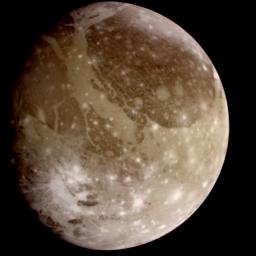
Mary Beth Murrill
Jet Propulsion Laboratory, Pasadena, CA
(Phone: 818/354-5011)
December 12, 1996
RELEASE: 96-255
Characterized by a soaring whistle and hissing static, Ganymede's song reveals that the Solar System's largest moon is also the only one known to possess a planet-like, self-generated magnetic cocoon called a magnetosphere, which shields the moon from the magnetic influence of its giant parent body, Jupiter.
Published in the scientific journal Nature this week, these new Galileo findings and other measurements from several Galileo sensors were presented today in a news briefing held at NASA's Jet Propulsion Laboratory (JPL), Pasadena, CA. Taken together, scientists say the new Ganymede findings are painting a portrait of a body that from the inside out closely resembles a planet like Earth rather than other moons in the Solar System.
"The data we get back is in the form of a spectrogram, and reading it is kind of like looking at a musical score," said Dr. Donald Gurnett, University of Iowa physicist and principal investigator on Galileo's plasma wave instrument. It was his experiment that first detected the telltale signals of a magnetosphere during the spacecraft's close flybys of that moon on June 27 and Sept. 6.
Gurnett said the unique pattern of frequencies his instrument detected is characteristic of a magnetosphere and closely matches his previous studies of the magnetospheres of Earth, Saturn and Jupiter. "The instant I saw the spectrogram, I could tell we had passed through a magnetosphere at Ganymede," Gurnett said.
Describing the electromagnetic wave activity that his experiment detected at Ganymede, Gurnett said the approach to the large moon was relatively quiet, "until all of a sudden, there's a big burst of noise that signals the entry into Ganymede's magnetosphere. Then, for about 50 minutes, we detected the kinds of noises that are typical of a passage through a magnetosphere. As we exited the magnetosphere, there was another big burst of noise."
Gurnett checked with Dr. Margaret Kivelson of the University of California at Los Angeles (UCLA), principal investigator for the magnetometer experiment on the spacecraft. Kivelson confirmed the detection of a large increase in magnetic field strength near Ganymede. Related data from the two close flybys have confirmed that Ganymede has a magnetic field of its own.
Using extremely precise data from tracking the spacecraft, investigators on Galileo's celestial mechanics team also have been able to confirm that Ganymede's interior is differentiated, probably having a three-layer structure. "These data show clearly that Ganymede has differentiated into a core and mantle, which is in turn enclosed by an ice shell," said JPL planetary scientist Dr. John Anderson, team leader on the Galileo radio science experiment.
"Combined with the discovery of an intrinsic magnetic field, our gravity results indicate that Ganymede has a metallic core about 250 to 800 miles in," said Anderson. "This is surrounded by a rocky silicate mantle, which is in turn enclosed by an ice shell about 500 miles thick. Depending on whether the core is pure iron or an alloy of iron and iron sulfide, it could account for as little as 1.4 percent or as much as one-third of the total mass of Ganymede."
This differentiated structure is the most likely cause of Ganymede's newly discovered magnetic field, which in turn gives rise to the magnetosphere, reported UCLA geophysicist Dr. Gerald Schubert, an interdisciplinary investigator on Galileo's science team. Scientists suspect Ganymede's magnetic field is generated the same way as Earth's, through the dynamo action of the fluid mantle rotating above a metallic core. The only other solid bodies in the Solar System known to have magnetic fields are Mercury, Earth and possibly Jupiter's volcanic moon Io.
"At Ganymede, the magnetic field is strong enough to carve out a magnetosphere with clearly defined boundaries within Jupiter's magnetosphere, making it the only 'magnetosphere within a magnetosphere' known in the Solar System," Kivelson said.
The strong magnetic characteristics of Ganymede, in combination with its residence within Jupiter's powerful magnetosphere, make the Jovian environment even more intriguing, said Galileo project scientists Dr. Torrence V. Johnson. "The physics taking place within Jupiter's magnetosphere are of great interest to scientists attempting to understand the complex interplay of magnetic forces and matter throughout the universe," he said.
Data from the plasma wave instrument can be heard and seen on the Galileo home page at the following URL: http://www.jpl.nasa.gov/galileo/.